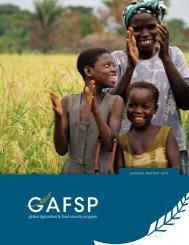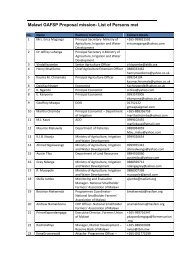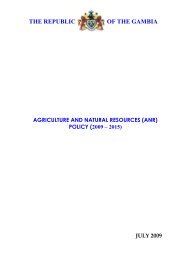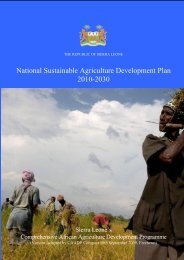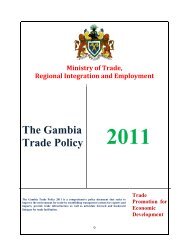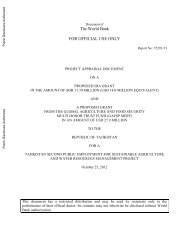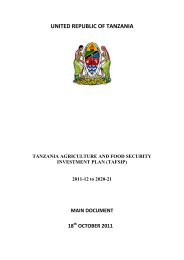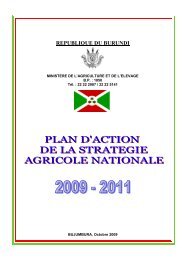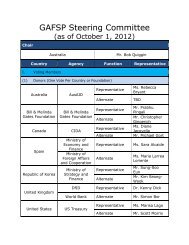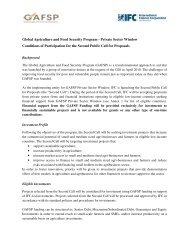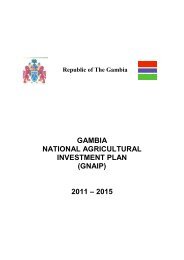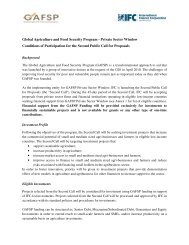Haiti: Poverty Reduction Strategy Paper; IMF Country Report 08/115 ...
Haiti: Poverty Reduction Strategy Paper; IMF Country Report 08/115 ...
Haiti: Poverty Reduction Strategy Paper; IMF Country Report 08/115 ...
Create successful ePaper yourself
Turn your PDF publications into a flip-book with our unique Google optimized e-Paper software.
CHAPTER 6<br />
Pillar 2: Human Development – Priority Accorded to Basic Social Services<br />
1. EDUCATION AND TRAINING<br />
POLICY TO REORGANIZE EDUCATIONAL SUPPLY IN FAVOR OF POOR STUDENTS<br />
101 The supply of education is inadequate at all instructional levels. The situation is particularly<br />
critical in rural areas. There are 23 communal sections that have no school at all, and 145 (in<br />
2007) that have no public school. According to 2004 data from the IHSI, the number of children<br />
under the age of 5 is estimated at 935,000, of whom 339,800, or 36.34 percent, are not covered by<br />
the system in place. In primary school, the number of children ages 6 to 12 and not enrolled is<br />
roughly 558,163, or 37.7 percent of the school-age population, with a very high degree of<br />
concentration (463,163) in rural areas.<br />
102 Out of the 122,311 students admitted to secondary school in 2004, only 81,709, or 66.8 percent of<br />
those accepted or 18 percent of the initial cohort, were able to receive secondary schooling owing<br />
to the limited capacity to accommodate students at this instructional level. Quite apart from the<br />
existing group of those who have already completed secondary school and been unable to find a<br />
space in the university, an additional 15,500 were admitted in 2004. In the final year of secondary<br />
school, the State university was able to take in 2,300 students from this class, while roughly<br />
double that number found spots in private institutions. Unmet demand is thus on the order of<br />
8,600 students, or 55.5 percent of the total student count seeking higher and university education,<br />
and this just for the academic year beginning in 2004 alone.<br />
103 More and more youths currently in school are asking for access to vocational training. The<br />
majority of the supply of such training is private and spaces are limited, particularly in urban<br />
areas where the network of agricultural training facilities, which are unequally distributed<br />
throughout the country, ceased to be operational a number of years ago owing to insufficient<br />
funding.<br />
Objectives<br />
104 The targeted objectives are the following:<br />
• Reducing the existing disparities between geographical departments and between urban<br />
and rural areas as regards the distribution of available schooling at the preschool and<br />
basic education levels<br />
• Ensuring that, by 2010, all 565 commune-level sections have at least one public school<br />
covering 6 grades<br />
• Introducing a basic education school (1st and 2nd cycles) that better addresses learners’<br />
needs, in particular those of older students<br />
• Making vocational education more accessible to a greater number of young people<br />
• Reducing average tuition costs for these instructional levels.<br />
Strategic lines<br />
• Creation and outfitting of new seated spaces in preschool<br />
• Creation and outfitting of new seated spaces in primary school<br />
• Scholarship programs or poor children in all commune-level sections<br />
• Resumed operation of the EMAs and CFPAs<br />
• Transformation of four nonpublic vocational training centers into reference centers.<br />
POLICY ON REQUALIFICATION OF INSTRUCTIONAL STAFF AND SCHOOL<br />
DIRECTORS<br />
105 The output of the system is quite low. At the basic level (1st and 2nd cycles) it is on the order of<br />
43 percent owing to the high grade repetition rates (29 percent in the first year) and dropout rates<br />
(6 percent) recorded for every year of studies. At the secondary school level, output is even<br />
38




